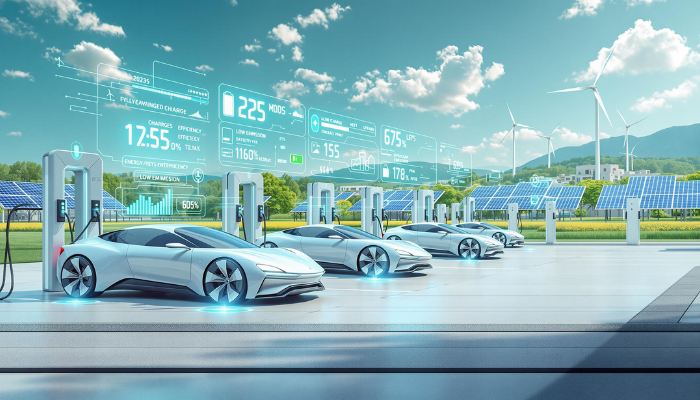Compliance with the ongoing problems of climatic change and the poor ecological state of the planet concerns automakers to start building new autos with less detrimental effects. The year 2025 is expected to be the decisive year for automobile market because car giants started producing electric and hybrid vehicles to help people decrease carbon footprints and avoid using fossil fuel. In the following article, the topic of our interest is electric cars in 2025; we will discuss the tendencies, innovations, related technologies, and future trends more widely.

1. Electrification of Vehicles: The Heart of Sustainable Driving
Consequently, the most important advancement in ‘green’ car technology is the evs. The leaders of many automaking companies have committed themselves to stop manufacturing the conventional gasoline-only cars by 2025. There are therefore factors such as improved batteries, increased consumer concern on green cars, and the policies aimed at prohibiting emission creeping carbon, which are all entrenching this transition.
Electric vehicles use high voltage lithium ion batteries which contain electrical energy ranging from a charging station or a regenerative brake system. Able to travel distances between 400 and 500 Km and has a special capability to travel the distance between 0 and 100 Km in less than five seconds. But they don’t release any pollution doing so, making them a better alternative to the conventional gas guzzling cars.
1.1. The Climate Leadership Coalition Update: Electric Vehicle Manufacturers Taking the Lead
However some carmakers are already starting this transition to electric cars and some are pioneers in creating green cars. For instance, the Tesla has defined what an electric vehicle should look like today with the Model 3, Model S, and Model X. Other auto making giants including GMs, Volkswagen and BMW also made commitments to introduce a series of electric cars in the market by 2025.
1.2. New Technology of Batteries
Electric cars depend much on the improved battery technology in the society nowadays. At present, lithium-ion batteries are the most common in e-mobility, however, engineers search for more effective solutions, including solid-state batteries that will provide longer range and contribute to the development of much faster charging time. QuantumScape and Solid Power are taking efforts to commercialize solid-state battery by 2025.
1.3. Running out of power, running out of charging stations.
For prospective EV buyers, there are two top issues; the place to recharge and the range anxiety which is the likelihood of running out of charge on a long journey. To address this challenge, governments and private investors globally are putting their monies into erecting numerous fast charging stations along highways and city outskirts.
1.4. Hydrogen Fuel Cell Vehicles: An Alternative to EVs
While the market of rather environmentally-friendly vehicles is currently populated mainly by electric cars, the hydrogen fuel cell vehicles (FCVs) have a great potential in pursuing a more sustainable transport future. FCVs create power by combining hydrogen fuel and oxygen and the only output is water vapor. Big automotive producers such as Toyota and Hyundai are already developing hydrogen fuel cell cars that can travel up to 600 kilometres on a single tank of hydrogen.
2. Hybrid and Plug-in Hybrid Electric Vehicles: A Bridge to the Future
As to the present trend in the automotive industry, there is no doubt that increasing passenger car demand is steadily contributing to the electric vehicle market, but the current important role is being played by hybrid and plug-in hybrid electric vehicles. These vehicles are hybrids where it incorporates an internal combustion engine and an electric motor together with rechargeable batteries, capable of being driven by electricity only, or fuel.
2.1. Benefits of Hybrid and PHEVs
Hybrid and PHEVs come with some benefits over regular gasoline cars, including better gas economy, fewer emissions, and cheaper running costs. They also produce little sound that interferes with drivers’ experience making them suitable for use in city roads.
2.2. The Ten Most Popular Hybrid and PHEV Models in 2025
The analysts also forecast that by 2025 automakers will offer a multitude of hybrids and PHEV models. The Toyota Prius, Honda Insight and Hyundai Ioniq are just some of the examples. Leading car makers such as Mercedes and BMW are also looking forward to introducing their up-market hybrid cars.
3. Eco Friendly Cars and Sustainable Material
Anther difference between eco-friendly automobiles and regular ones is that the former uses environmentally friendly components during construction. Buyers of automobiles are finding recycled metals, bio based plastic, and natural fiber in automobiles to avoid negative effect on the environment.
3.1. Bio-based Plastics
The bio-plastics developed from reworkable raw material like corn, sugarcane or cellulose are now used in vehicle parts like seats, instrument panel or trim. The use of these sustainable materials results in a lower consumption of petroleum based plastics to make products so they are emitting less carbon.
3.2. Recycled Metals
In the recycling of Aluminum, steel and copper it has been found that recycling of such metals saves natural resources and also the amount of energy that would be used in the extraction of the metals. Automobile companies have recently resorted to utilising recycled metal in their cars to make their manufacturing cycle environmentally friendly.
Conclusion
The future therefore belongs to economic cars and the growth of green cars is expected to rise by 2025. Thanks to the progressive changes in electric vehicles and batteries, as well as their increasing popularity, we are observing a shift towards both cleaner and more environment-friendly automobile industry. In addition, the production of these vehicles incorporates the use of sustainable materials hence UN-CF’s continuous strive to fight climate change.
With the world going green, it will be inevitable for the automobile industry not to shift to developing friendly car models. Both the demands for technological values and the loyalty of the large automotive industry to mass production undeniably create a revolution in eco-friendly driving. That said, fasten your seatbelt and let’s take a ride to the year 2025 to a green transportation culture already.




